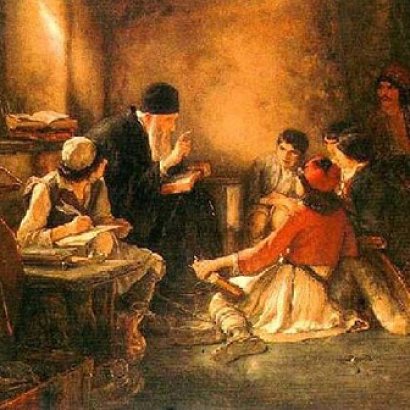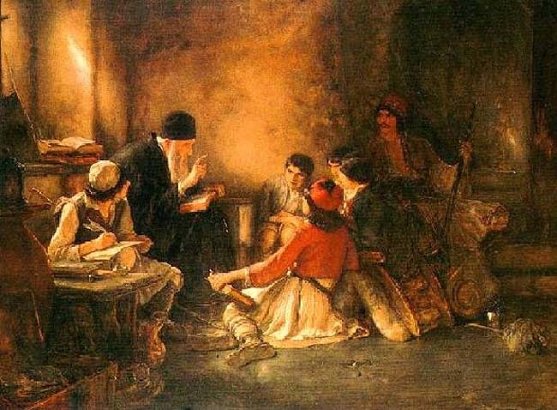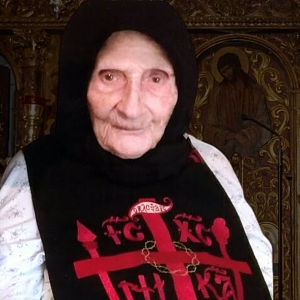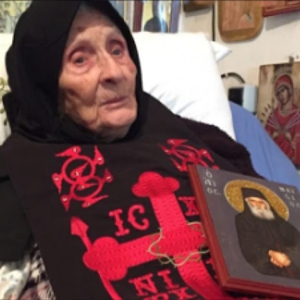1. Article 105 of the Constitution of Greece of 1975/1986, currently in force, which is an exact repetition of the contents of previous constitutions, i.e., Articles 106 - 109 of the Constitution of the Fourth National Assembly of Athens, published 1926, Articles 109 - 112 of the Constitution of 1927, Article 103 of the Constitution of 1952, and Article 122 of the Constitution of 1968.
2. The Charter of the Holy Mountain, which was originally drafted by a fivemember committee in Karyes in May 1924 and was voted by the Extra-ordinary Double Synaxis of the Twenty Monasteries, and which was then submitted to the Greek Government, which, having given it for further elaboration to a special committee, which took into account the amendments proposed by the Ecumenical Patriarchate, proceeded to its ratification by the Legislative Decree of 10/16 September 1926.
3. The Legislative Decree of 10/16 September 1926 ‘concerning the ratification of the Charter of the Holy Mountain’. This contains other provisions which regulate the organisation, the administration, and the administration of justice on
the Holy Mountain.
4. Provisions of imperial chrysobulls, Patriarchal sigillia, firmans of the Sultans, etc. which have not been rescinded by the Charter of the Holy Mountain and the Legislative Decree of 10/16 September 1926.
5. The regulative provisions of the Extra-ordinary Twenty-Member Synaxis. These provisions are issued following the relevant delegation, but in order to have force must first be communicated to the Governor of the Holy Mountain and
then be ratified by the Minister of Foreign Affairs, unless such provisions deal with matters of a purely spiritual nature, in which case they are communicated to the Ecumenical Patriarchate for approval.
6. The Internal Regulations of the monasteries and sketes, which are approved by the Holy Community and the Ruling Monasteries, on condition, of course, that they do not conflict with the provisions of the Charter of the Holy Mountain.
7. Customs which have not been abolished.
On the basis of these legislative texts, a brief account will now be given of the whole structure of the administrative system currently prevailing on the Holy Mountain. Thus, the peninsula of Athos, from Megali Vigla onwards, is, in
accordance with its ancient privileged status, a self-administering part of the Greek State, whose sovereignty over it remains unaffected. In spiritual terms, the Holy Mountain is within the direct jurisdiction of the Ecumenical Patriarchate. All who live the monastic life here acquire Greek citizenship as soon as they are accepted as novices or monks, without any other formality.
The Holy Mountain is administered, according to the status which it enjoys, by the Twenty Monasteries, among which the whole of the Athos peninsula, whose territory is not subject to expropriation, is divided up.
Its administration is carried out by representatives of the monasteries, who make up the Holy Community. Absolutely no change is permitted in the system of administration or in the number of the monasteries, nor in their rank in the
hierarchy or their position in regard to their dependencies. It is prohibited for heterodox or schismatics to live on the Holy Mountain.
The detailed determination of the Athonite institutions and of the manner of their operation is made by the Charter of the Holy Mountain, which, in consultation with the representative of the State, is drawn up and voted by the Twenty Monasteries and ratified by the Ecumenical Patriarchate and the Greek Parliament.
The exact observance of Athonite institutions is, in spiritual matters, under the supreme supervision of the Ecumenical Patriarchate, and, in administrative matters, under the supervision of the State, which is exclusively responsible for
maintenance of public order and security.
The above powers of the State are exercised by a Governor, whose rights and duties are determined by law. Also determined by law is the judicial power exercised by the monastic authorities and the Holy Community, as well as the
customs and tax privileges enjoyed by the Holy Mountain (Article 105 & 1 - 5 of the 1975/86 Constitution).
Thus, by virtue of this provision of the Constitution, two administrative authorities must co-exist on the Holy Mountain: a civil administrative authority and a monastic administrative authority. To the first belongs the Governor of the Holy Mountain, who is appointed by a Legislative Decree originating with the Minister of Foreign Affairs, to whose jurisdiction he belongs. The Governor’s supervision extends not only to those matters which concern public order and
security, but also to the observance of the Charter of the Holy Mountain. He also draws the attention of the Holy Community to infringements committed by any monastic authority on the Holy Mountain. In the exercise of these duties, the Governor comes into direct contact with the Holy Community and the other monastic authorities by correspondence. In the event of his absence or of some impediment to the performance of his duties, his secretary acts for him. The Governor is also in charge of the officials within his jurisdiction, that is, the police force and the Governor’s staff in the execution of the decisions of the Holy Community and of the monastic authorities (Articles 3 - 5, Legislative Decree 10/16.9.1926).
Subject to the second of these authorities, that is, the monastic administrative authority, with a view to safeguarding the self-administration which the Holy Mountain enjoys, are the individual administrative organs and the collective
organs of each of the Twenty Ruling, Royal, Patriarchal and Stavropegic Monasteries, whose number and position in the hierarchy cannot be changed, and the general administrative organs of the Holy Mountain, which are the Holy
Community, the Holy Epistasia, and the Extra-ordinary Twenty-Member Synaxis. These monasteries are termed ‘Ruling’ not only because that is the name which they are given on the Mountain and because they govern themselves in accordance with their own Internal Regulations, but also because subject to them are all the dependencies on the Holy Mountain, that is, the sketes, kellia, kalyves, hesychasteria, and kathismata, according to long-established order. They are called ‘Royal and Patriarchal’ because either they were founded or they were under the protection of kings or Patriarchs, and ‘Stavropegic’ because there is located in them a cross specially sent by the Ecumenical Patriarchate. Thus the monasteries are ranked in the following hierarchical order, which cannot be changed:
The Megiste Lavra, founded in 963.
Vatopaidi, founded in 972.
Iveron, also founded in 972.
Chilandari, founded in 1197 (Serbian).
Dionysiou, founded in 1375.
Koutloumousiou, founded in the 12th century.
Pantocrator, founded in 1363.
Xeropotamou, founded in 970 (?).
Zographou, founded c. 973 (Bulgarian).
Docheiariou, founded c. 970.
Karakallou, founded in the early 11th century.
Philotheou, founded around the end of the 10th century.
Simonopetra, founded in the first half of the 14th century.
Aghiou Pavlou, founded in the second half of the 10th century.
Stavroniketa, 1541.
Xenophontos, founded in the late 10th century.
Gregoriou, founded before the middle of the 14th century.
Esphigmenou, founded in the late 10th century.
Rossikon (St Panteleimon), founded in the 10th century.
Konstamonitou, founded in the 11th century.
In earlier times, these monasteries were divided into the ‘coenobitic’ and the ‘idiorrhythmic’, depending upon the way in which they were organised and administered. Today they continue not only to govern themselves, in accordance,
that is, with the provisions of their Internal Regulations, which are voted by the monasteries themselves and ratified by the Holy Community, the supervisory authority, but also manage their own property and financial affairs. Today, all the
monasteries of the Holy Mountain without exception are coenobia. The following make up the dependencies of these Ruling Monasteries: the sketes, that is, a group of ‘kalyves’ (see below) or ‘kalyvia’ or of even smaller dwellings, such as the ‘hesychasteria’, the ‘kathismata’, the ‘erimitiria’, and the ‘enkleistres’, which is governed by Internal Regulations approved by the Ruling Monastery. There are 12 sketes: four coenobitic and eight idiorrythmic.
The following are coenobitic: 1. the Skete of the Dormition of the Theotokos (Bogoroditsa) of the Monastery of St
Panteleimon (Rossikon); 2. the Skete of the Prophet Elijah of the Pantocrator Monastery; 3. the Skete of St John the Baptist of the Megiste Lavra Monastery; 4. the Skete of St Andrew of the Vatopaidi Monastery.
The following are idiorrythmic: 1. the Skete of St Anne of the Megiste Lavra Monastery; 2. the Skete of the Holy Trinity - Kafsokalyvia of the same monastery; 3. the Skete of St John the Baptist of the Iveron Monastery; 4. The Skete of St Demetrius of the Vatopaidi Monastery; 5. the Skete of St Panteleimon of the Koutloumousiou
Monastery; 6. the Skete of the Nativity of the Theotokos (Nea Skiti) of the Monastery of Aghiou Pavlou; 7. the Skete of St Demetrius (Lakkou) of the same monastery; 8. the Skete of the Annunciation of the Theotokos of the
Xenophontos Monastery. Each skete must keep unchanged its organisation and administration, determined for it by Internal Regulations approved by the Ruling Monastery, which must not conflict with the provisions of the Charter of the Holy Mountain.
The ‘kellia’ are a kind of monastic agricultural dwelling, each inhabited by a monk who is termed the yerontas’ (elder) and is familiar with the monastic life, which he has lived as a brother of the Ruling Monastery. However, it is usual for
two other monks to join him, and these three may accept another three novices or disciples, but it is not permitted for their numbers to further increase beyond this limit. The ‘kalyves’, the ‘hesychasteria’, the ‘kathismata’, the ‘erimitiria’, and the ‘enkleistres’ are sacred places belonging to the Ruling Monasteries in which one monk, usually, lives the monastic life, dependent upon the charity of the monasteries and the fruits of the earth.
The individual administrative organs of the monasteries and their dependencies include: the Abbot in the case of the monasteries. The Abbot is elected for life. To be eligible for election, he must: a. be of good morals, undeviating piety, and unimpeachable conduct, have theological learning and a general education, and administrative ability; (b) be at least 40 years old; (c) have been tonsured on the Holy Mountain, preference being given to a monk who has been on the register of the monastery for 10 years or more; (d) must not have been convicted of malversation of monastic property. Where the brotherhood of a monastery finds that there is no candidate among them with the qualifications expressly laid down by the Charter, it is permissible for any monk of the Holy Mountain who is regarded as suitable to be Abbot of the monastery to be invited to take office. The Abbot is elected in a secret ballot by all the brothers
of the monastery who have been monks for at least six years, from the time of their tonsure. A copy of the minute of the election is sent to the Holy Community, so that the Abbot can be installed in accordance with custom, and for the
notification of the Ecumenical Patriarchate of the election. The Abbot, as spiritual father, alone exercises spiritual power over the brothers of the monastery. He supervises, that is to say, their spiritual state, deters them from any divergence from the right path, and leads them by his teaching and the example of his life to the fulfilment of their vocation. For this reason his brother monks owe him reverence and obedience. In the exercise of his administrative
powers he must work together with the ‘Committee’ (see below); this means that he cannot take action without obtaining the opinion of the Committee, and the Committee cannot take action without obtaining his. For this reason, the Abbot and the Committee together constitute the executive authority for the decisions of the ‘Council of Elders’ (see below). In no circumstances is the concentration of all the powers of administration in the hands of the Abbot or the usurpation by him of the rights of the Committee or of the Council of Elders permitted.
The individual organ in the case of the sketes is the Dikaios. To be eligible for election to this office, a monk must be one of the yerontes of the kalyves who is distinguished by his merits and his administrative ability in the eyes of the Ruling Monastery. The Dikaios is elected in early May by the yerontes of the kalyves and his term of office is a year. The duties of the Dikaios are to live in the dwelling-house and not in his kalyva, to be responsible for the internal order of the skete, to entertain guests, to conduct the services in the kyriakon, the central church, to be alert, together with the ‘Councillors’ to the conduct of all the members of the skete, warning and advising them, to report those who are
recalcitrant and incorrigible to the ‘Synaxis of Elders’ and through this to the Ruling Monastery, and to be responsible for the safekeeping of the sacred treasures, vessels, vestments, manuscripts, books, and all the objects of value of
the skete in general.
The collective administrative organs of the monasteries and dependencies include: the ‘Committee’ and the ‘Council of Elders’ in the Ruling Monasteries and the ‘Councillors’ and the ‘Synaxis of Elders’ in the sketes. Here it should be
added that in earlier times in idiorrythmic monasteries the collective administrative organs included the ‘Administrative Committee’ and the ‘Synaxis of Seniors’. The Commitee consists of two or three members drawn from the Council of Elders. Their term of office is a year and they are also elected by the Council of Elders. The Committee always works together with the Abbot, who is its chairman, and with him is responsible for the administration and management
of the monastery. Candidates for membership of the Council of Elders must be distinguished for their probity and administrative ability. Preference is also given to those with some theological training and any form of general education. The details of their election are contained in the Internal Regulations of each monastery. Those who are elected, however, hold office for life, unless they forfeit their office as the result of some conviction for wrongdoing. In the event that the Abbot, after a first and second warning, recorded in the minutes, does not correct a matter complained of, he is relieved of his office, if this is the wish of two-thirds of the members of the Council of Elders. Otherwise, if this is not the wish of the majority of the brotherhood, the Holy Community is invited to resolve the dispute, given that it is the supreme authority which supervises the faithful observance of the Charter of the Holy Mountain.
The members of the Committee and the members of the Council of Elders must set an example of coenobitic life by attending the common refectory with their brethren, giving lessons in practice in poverty and love, caring for the sick
and aged, and by showing, first and foremost, full respect for the authority of the terms and institutions of coenobitic life.
The ‘Councillors’ at each skete number from two to four. Half are elected in the same way as the Dikaios and the other half by the Ruling Monastery. Where there are two Councillors, their term of office is a year. Where, however, there are three of them, one or more are replaced each year. Where there are four Councillors, either two or all four are replaced, according to the prevailing practice at each skete. Each skete has its own seal, which bears its name and
that of the Ruling Monastery. This is in three or four parts, each Councillor keeping one of them. The Dikaios and the Councillors must work together to promote the interests of their skete. Any unilateral act, other than their normal
duties, cannot be regarded as valid. All affairs of any importance to the skete are put before the Synaxis of Elders, but its decisions must be approved by the Ruling Monastery. Also included in the general administrative organs of the Holy Mountain, as we have said above, are the Holy Community, the Holy Epistasia, and the Extra-ordinary Twenty-Member Synaxis.
The Holy Community of the Holy Mountain, which has its seat at Karyes, is a standing body which consists of a representative of each of the twenty Ruling Monasteries. These representatives are each elected by the monastery from which they come in accordance with the Internal Regulations of that monastery at the latest within the first two weeks of the month of January each year. Candidates for the office of representative must be drawn from among the
brothers of the monastery, be at least 30 years of age, and be known for the blamelessness of their lives, preference always being given to those with theological training and a general education. Their term of office is a year, but this may be extended if their monastery re-elects them. The Holy Community meets in regular session three times a week, and in extra-ordinary session as the need arises. For this reason the representatives live in Karyes, so that they can attend all meetings of the Holy Community. The discussions at its meetings are chaired by the Protepistates. The meetings have a quorum if two-thirds of the representatives, that is, fourteen, are present. The Governor of the Holy Mountain may attend these meetings if invited.
The Holy Epistasia represents the executive authority of the Holy Community and is made up of four members. For this purpose, the twenty monasteries are divided into five groups of four, each one of which serves on the Holy Epistasia for one year in every five, more specifically, from 1 June to 31 May. For this purpose an ‘Epistates’ - who must have the same qualifications as those of the representatives of the monasteries - is sent each year from each monastery in each group of four. The Epistates of the senior monastery is called the Protepistates and presides over the Holy Epistasia, and as a symbol of his powers carries the staff of the Protos. The five groups mentioned above are as follows:
Group A: Megiste Lavra, Docheiariou, Xenophontos, and Esphigmenou.
Group B: Vatopaidi, Koutloumousiou, Karakallou, and Stavroniketa.
Group C: Iveron, Pantocrator, Philotheou, and Simonopetra.
Group D: Chilandari, Xeropotamou, Aghiou Pavlou, and Gregoriou.
Group D: Dionysiou, Zographou, St Panteleimon, and Konstamonitou.
The Epistates live all the time in Karyes, but may be absent in turn and in the order of the hierarchy when their duties demand this. The Protepistates, however, may not absent himself from his headquarters. The Epistates are equal
among themselves, and the Protepistates primus inter pares. Decisions are taken by a majority; in the event of a tied vote, the matter is brought before the Holy Community for its decision. Any decision of the Holy Epistasia which is
taken without the knowledge of one of the Epistates is invalid. Among the duties of the Holy Epistasia is that of handling and setting its seal on the correspondence of the Holy Community. The seal of the Holy Community
has in the centre an image of the Theotokos, is delivered on each occasion to the new Epistates in accordance with long-established order, and is also divided into four parts of which each Epistates keeps one. The Holy Epistasia is also reponsible for the cleanliness and repair of the streets of Karyes, and for their lighting, for carrying out public health inspections, for fixing the prices of foodstuffs, for ensuring decent behaviour, by the prohibition of disorder, singing, etc., in the main streets, for monitoring the opening hours of shops, etc. Finally, the Holy Epistasia manages the the Common Fund on the reponsibility of the monasteries.
The Extra-ordinary Twenty-Member Synaxis consists of the Abbots and Heads of the twenty monasteries. This meets ipso jure twice a year, fifteen days after Easter, and on 20 August. The Extra-ordinary Twenty-Member Synaxis is the
supreme legislative and judicial body on the Holy Mountain. All spiritual matters are subject to the Ecumenical Patriarchate, as the supreme court. The Ecumenical Patriarchate also approves regulatory provisions which are of a spiritual character and are voted by the Extra-ordinary Twenty- Member Synaxis.
It is by these methods of organisation and administration of the Holy Mountain that the quiet, the patience, the obedience, the humility, and the general order and discipline which should prevail on the Holy Mountain are feguarded with precision.




